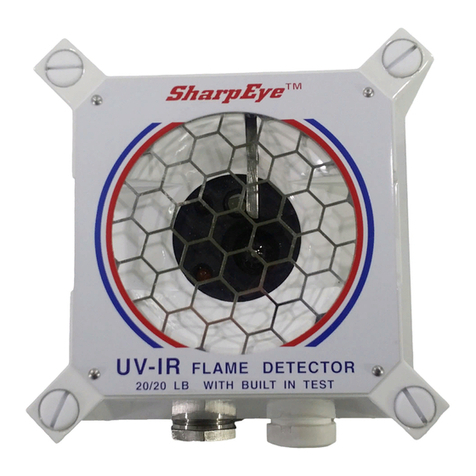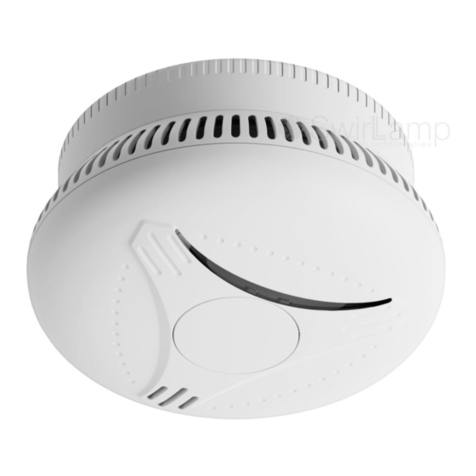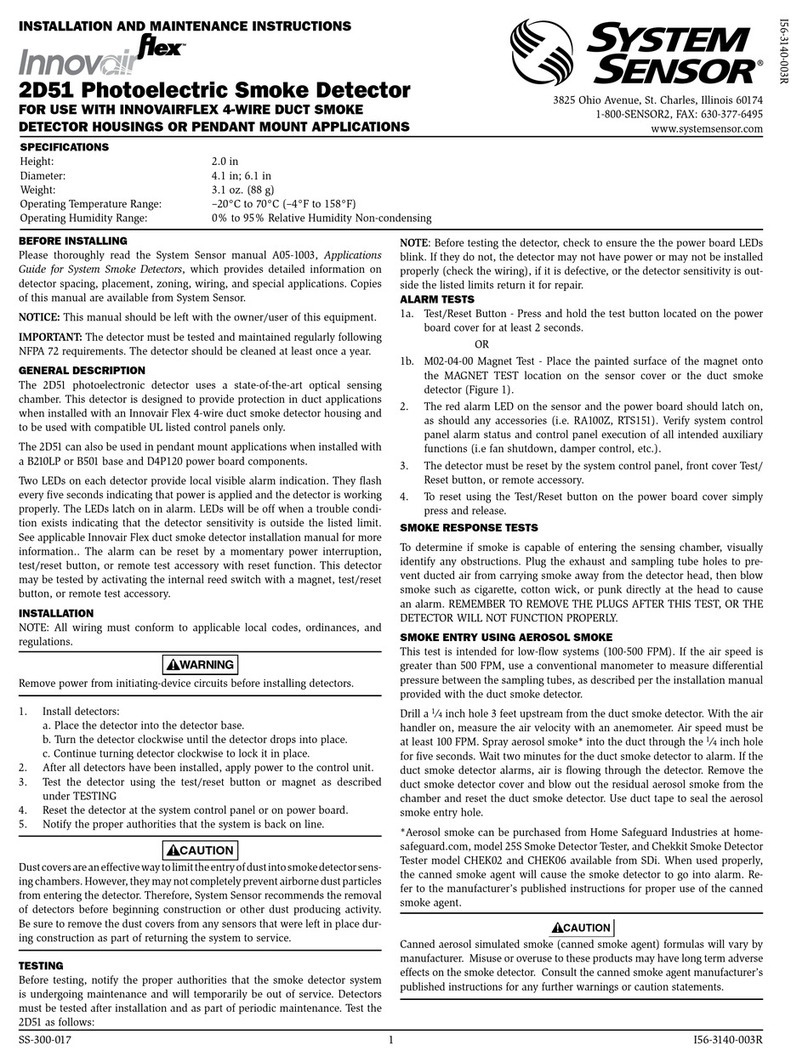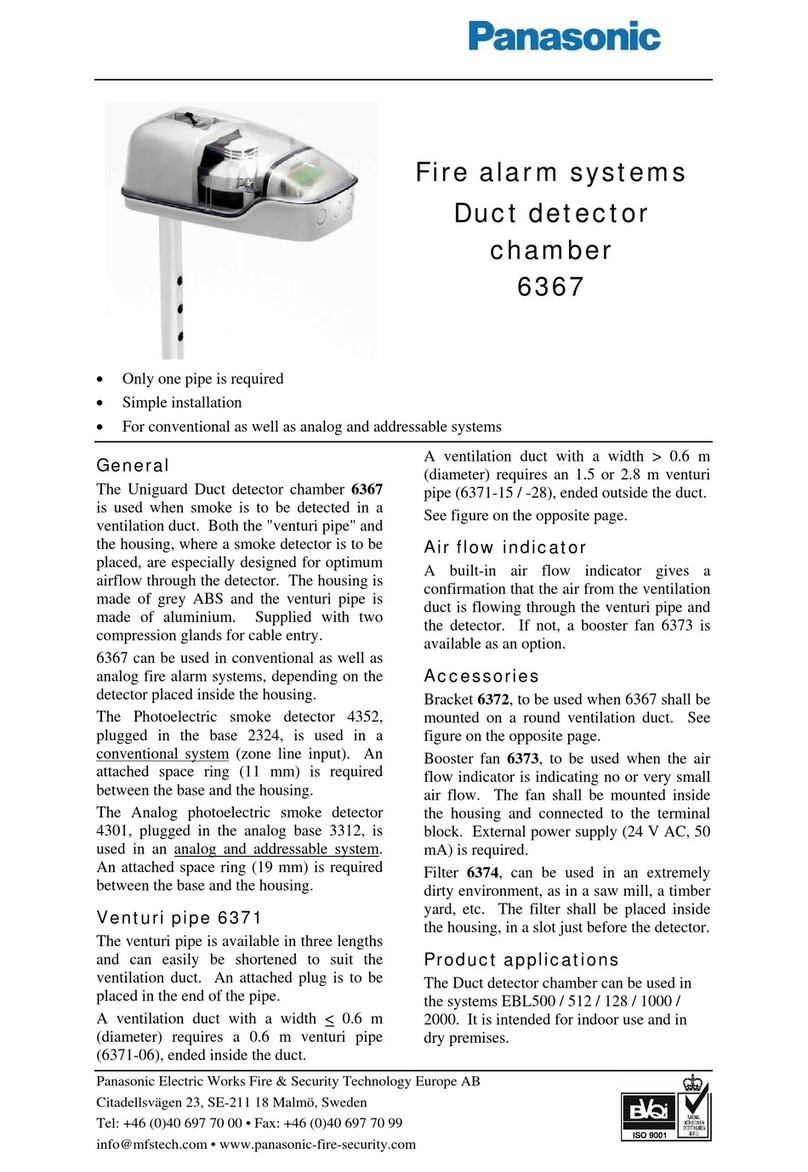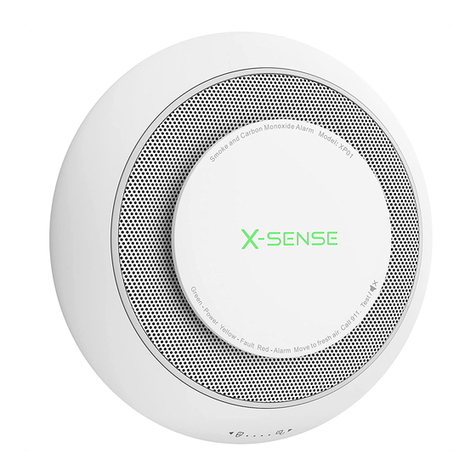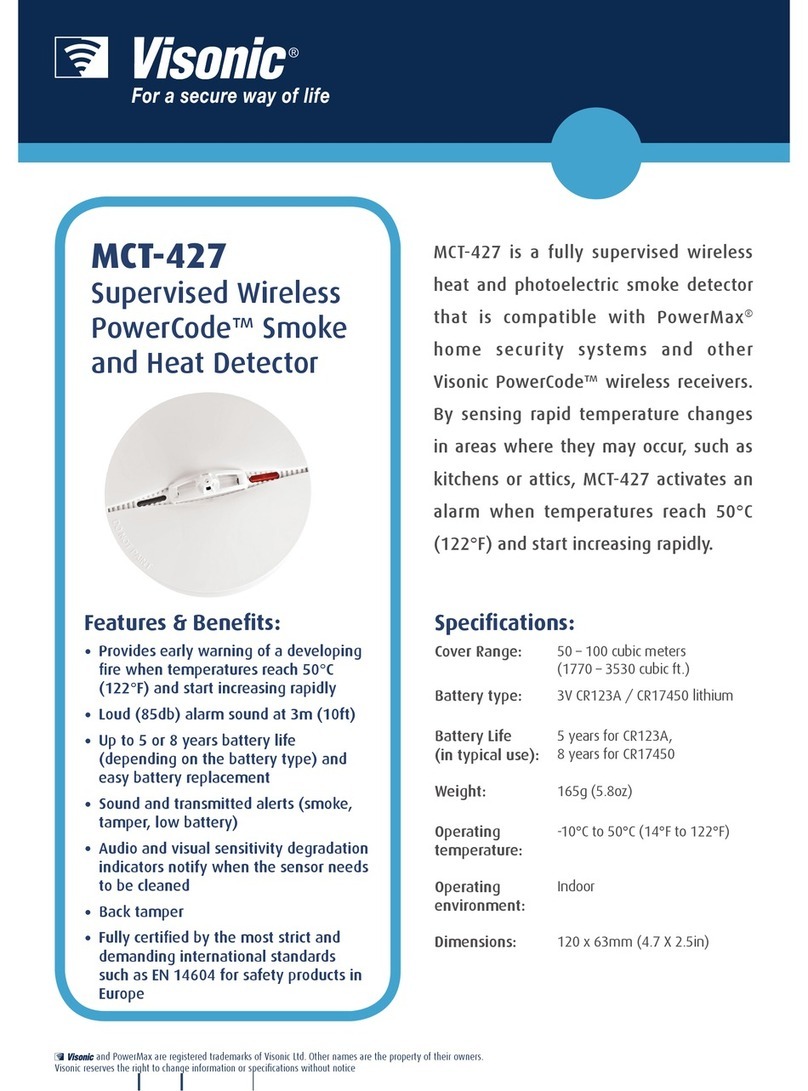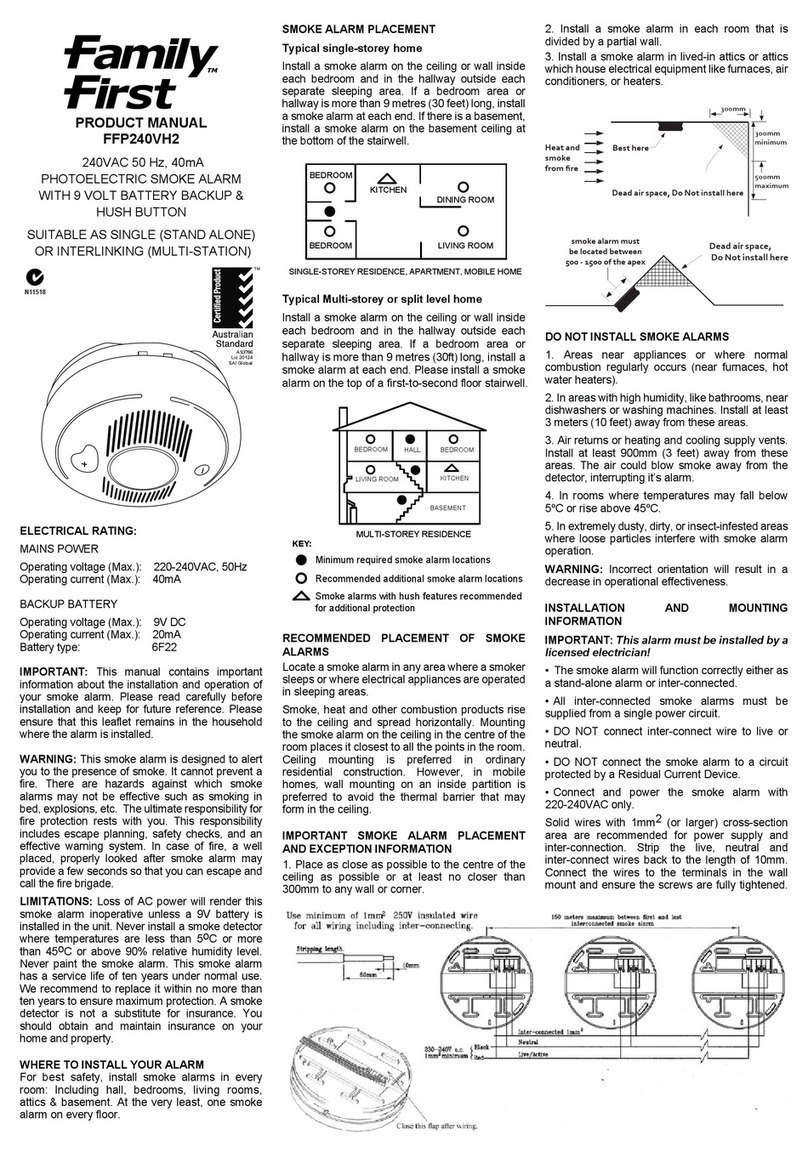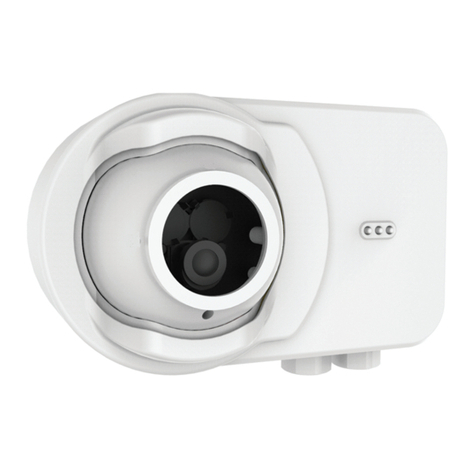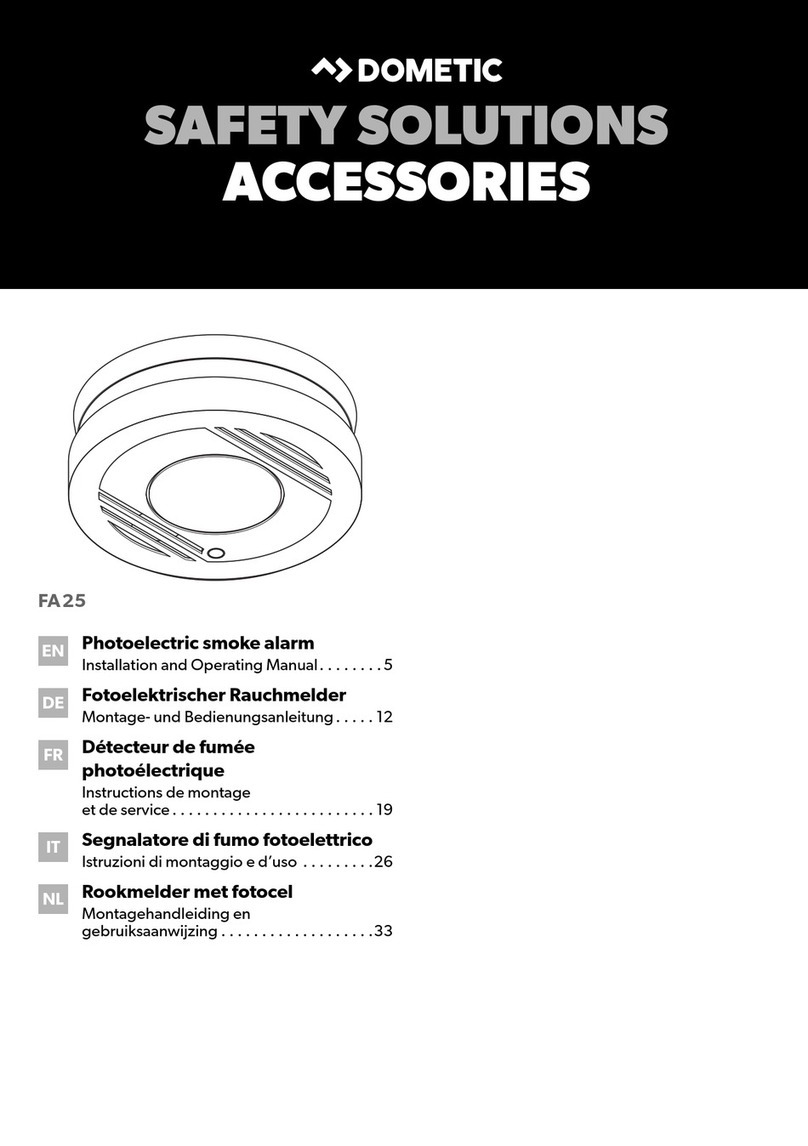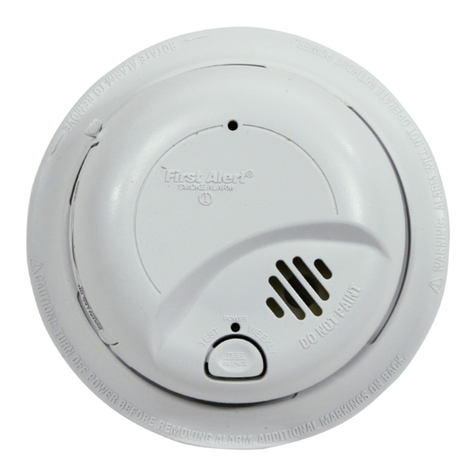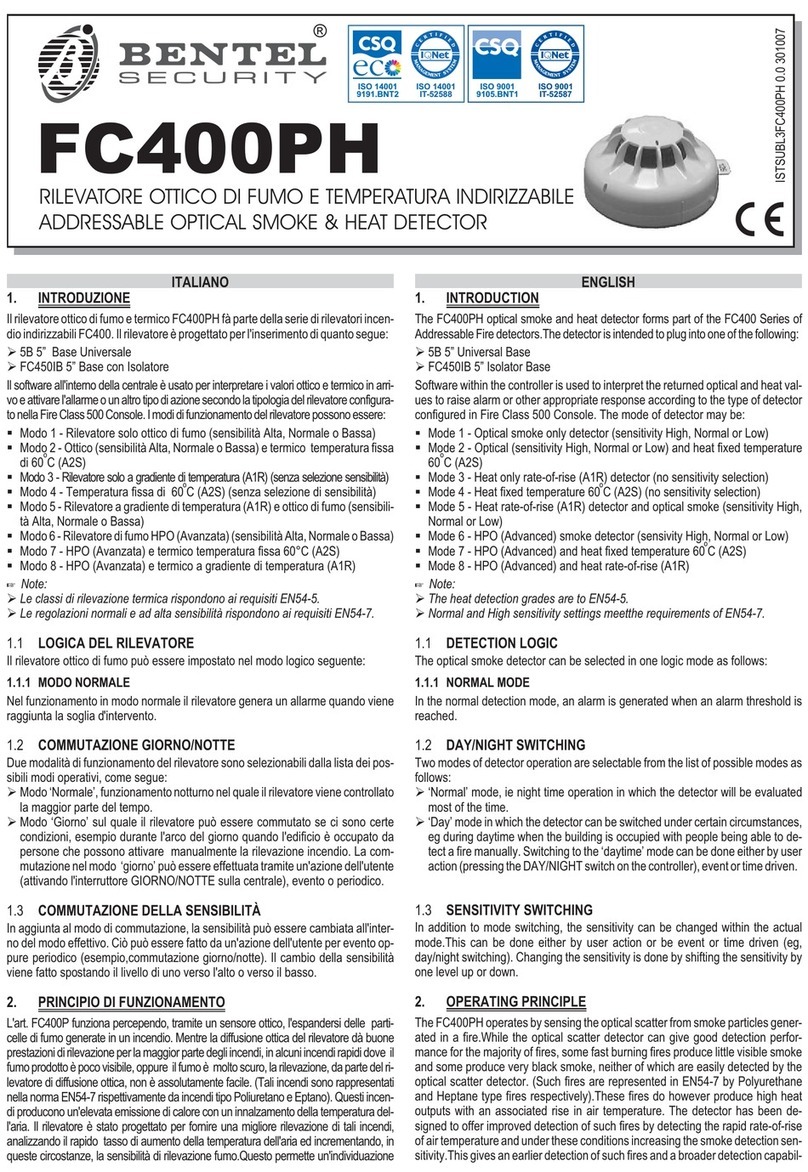SharpEye 20/20CTIN Operating instructions

CCTV Model Flame Detector
Model 20/20CTIN-CTIP
User and Maintenance Manual
TM 788100, Rev. A January 2005
ATEX Approved
Ex II 2G
EExd IIB + H2T5
EExde IIB + H2T5
UL Approved
Class I, Groups C and D Gost R Approved
1ExdIIBT5/H2
218 Little Falls Rd., Cedar Grove, NJ 07009 USA;
Phone: +1 (973) 239 8398 Fax: +1 (973) 239 7614


The SharpEye Optical Flame Detector described in this document is the property
of Spectrex, Inc.
No part of the hardware, software or documentation may be reproduced,
transmitted, transcribed, stored in a retrieval system, or translated into any
language or computer language, in any form or by any means, without prior
written permission of Spectrex, Inc.
While great efforts have been made to assure the accuracy and clarity of this
document, Spectrex, Inc. assumes no liability resulting from any omissions in this
document, or from misuse of the information obtained herein. The information in
this document has been carefully checked and is believed to be entirely reliable
with all of the necessary information included. Spectrex Inc. reserves the right to
make changes to any products described herein to improve reliability, function, or
design, and reserves the right to revise this document and make changes from
time to time in content hereof with no obligation to notify any persons of revisions
or changes. Spectrex, Inc. does not assume any liability arising out of the
application or any use of any product or circuit described herein; neither does it
convey license under its patent rights or the rights of others.
Warning:
This manual should be carefully read by all individuals who have or will have
responsibility for using, maintaining or servicing the product.
The Detector is not field-repairable due to the meticulous alignment and
calibration of the sensors and the respective circuits. Do not attempt to modify or
repair the internal circuits or change their settings, as this will impair the system's
performance and void the Spectrex, Inc. Product warranty.


Spectrex Inc. - SharpEyeTM CCTV Model Flame Detector Manual – TM 788100, Rev. A January 2005
I
TABLE OF CONTENTS
1. Scope ....................................................................................................1
1.1 PRODUCT OVERVIEW .....................................................................................1
1.2 DOCUMENT OVERVIEW...................................................................................2
2. Technical Description..........................................................................3
2.1 PRINCIPLES OF OPERATION............................................................................3
2.1.1 Hydrocarbon fire detection....................................................................3
2.1.2 Identifying the CO2peak.......................................................................3
2.1.3 The limitations of IR-IR flame detectors................................................3
2.1.4 The advantages of IR3 technology .......................................................3
2.1.5 Video Picture ........................................................................................5
3. Performance .........................................................................................6
3.1 DETECTION SENSITIVITY.................................................................................6
3.2 FALSE ALARMS PREVENTION ..........................................................................9
4. Operation............................................................................................10
4.1 VISUAL INDICATIONS ....................................................................................10
4.2 OUTPUT SIGNALS ........................................................................................11
4.2.1 Optional latching.................................................................................12
4.2.2 Built-In-Test (BIT) ...............................................................................12
4.2.3 CCTV Output......................................................................................12
4.3 MODE SELECTION........................................................................................13
4.3.1 Function Setup....................................................................................14
4.3.2 Sensitivity Ranges ..............................................................................14
4.3.3 Alarm Delay........................................................................................15
4.3.4 Addresses Setup ................................................................................15
4.4 BUILT IN TEST .............................................................................................16
5.Technical Specifications.....................................................................18
5.1 ELECTRICAL SPECIFICATIONS .......................................................................18
5.2 MECHANICAL SPECIFICATIONS ......................................................................21
5.3 ENVIRONMENTAL SPECIFICATIONS.................................................................22
6. Installation Instructions.....................................................................23
6.1 SCOPE........................................................................................................23
6.2 GENERAL CONSIDERATIONS .........................................................................23
6.3 PREPARATIONS FOR INSTALLATION................................................................24
6.4 CONDUIT INSTALLATION................................................................................24
6.5 DETECTOR MOUNTING .................................................................................25
6.5.1 Swivel Mount Kit:................................................................................25
6.5.2 Swivel installation (Figs. No. 8 and 9):................................................25
6.6 WIRING (REFER TO FIG. 11) .........................................................................28
6.7 TERMINAL WIRING (SEE FIG. NO.10 AND NO.11.)...........................................29
6.8 OPERATION MODE .......................................................................................32
7. Operating Instructions......................................................................33
7.1 SCOPE........................................................................................................33
7.2 POWER-UP.................................................................................................33
7.3 RESET ........................................................................................................33

Spectrex Inc. - SharpEyeTM CCTV Model Flame Detector Manual – TM 788100, Rev. A January 2005
II
7.4 FUNCTIONAL TESTING...................................................................................33
7.4.1 Manual BIT Test .................................................................................34
7.4.2 Testing with fire simulator...................................................................34
7.5 SAFETY PRECAUTIONS .................................................................................35
8. Maintenance Instructions..................................................................36
8.1 SCOPE........................................................................................................36
8.2 MAINTENANCE INSTRUMENTATION AND PERSONNEL .......................................36
8.3 PREVENTIVE MAINTENANCE PROCEDURES.....................................................36
8.4 PERIODIC MAINTENANCE PROCEDURES.........................................................36
8.4.1 Power-Up Procedure ..........................................................................36
8.4.2 Functional Test Procedure..................................................................36
8.5 MAINTENANCE RECORDS..............................................................................37
8.6 TROUBLESHOOTING .....................................................................................37
8.6.1 Fault Indication ...................................................................................37
8.6.2 False Alarm or Warning Indication......................................................37
Appendix A - Wire Selection Tables .....................................................39
Appendix B – Typical Wiring Configurations.......................................41
Appendix C – RS-485 Communication Network ..................................45
Appendix D - Mounting the “EExde approved” version......................47
Appendix E - Long Range IR3 Fire Simulator ......................................51

Spectrex Inc. - SharpEyeTM CCTV Model Flame Detector Manual – TM 788100, Rev. A January 2005
III
LIST OF FIGURES
Figure 1: CCTV Model Flame Detector............................................................................. 4
Figure 2: Flame Detector Assembly - Outline Drawing .................................................... 5
Figure 3: Horizontal and Vertical Fields of View.............................................................. 8
Figure 4: Indication LEDs................................................................................................ 10
Figure 5: CCTV Screen Setup........................................................................................... 13
Figure 6: Electrical Interface........................................................................................... 18
Figure 7: Flame Detector Assembly - Schematic Section ................................................ 20
Figure 8: IR3 Detector and Swivel Mount Assembly........................................................26
Figure 9: Swivel Mount Assembly - Outline Drawing...................................................... 27
Figure 10: Terminal Board............................................................................................... 30
Figure 11: IR3 Flame Detector with cover removed........................................................ 31
Figure 12: Flame Detector Wiring Diagram....................................................................41
Figure 13: Typical wiring diagram for 4 wire controllers...............................................42
Figure 14: 4-20mA wiring................................................................................................ 43
Figure 15: RS-485 networking.......................................................................................... 45
Figure 16: Flame Detector Assembly - Wiring Diagram................................................. 49
Figure 17: Flame Detector Assembly - Wiring Diagram (“de version”) ........................50
Figure 18: Fire Simulator................................................................................................. 51
Figure 19: IR3 Detector Target Point.............................................................................. 52
LIST OF TABLES
Table 1: Alarm Response Time Versus Range.................................................................... 6
Table 2: Response Sensitivity Ranges................................................................................. 7
Table 3: Cone of Vision ...................................................................................................... 8
Table 4: Immunity To False Alarm Sources....................................................................... 9
Table 5: Welding Immunity Distance ................................................................................. 9
Table 6: Output Signals Versus Detector State ................................................................ 11
Table 7: Built-in Test........................................................................................................ 12
Table 8: Functions setting for model 20/20 CTIN and model CTIP................................ 14
Table 9: Sensitivity range ................................................................................................. 14
Table 10: Time delay ........................................................................................................15
Table 11: Contact Ratings................................................................................................ 19
Table 12: Mounting according to US Version..................................................................25
Table 13: Mounting according to EU Version ................................................................. 25
Table 14: Maximum DC resistance at 68˚F for copper wire............................................ 39
Table 15. Wiring length in feet (meter)............................................................................. 39

Spectrex Inc. - SharpEyeTM CCTV Model Flame Detector Manual – TM 788100, Rev. A January 2005
IV

Spectrex Inc. - SharpEyeTM CCTV Model Flame Detector Manual – TM 788100, Rev. A January 2005
1
1. Scope
1.1 Product Overview
The SharpEye CCTV Model Flame Detector (20/20CTIN and 20/20CTIP) is a self-
contained, triple-spectrum, optical flame detector that incorporates a video color
camera. The detector's IR sensors and spectral band pass filters have been
selected to ensure the greatest degree of spectral matching to the radiant energy
emissions of fire and the lowest degree of matching to non-fire stimuli.
The color video camera enables the user to investigate the monitored area, to
identify the fire's source and location, and help select the best response to the
situation (activation of fire suppression means).
Configuration can be made to issue a live color video picture signal at all times, on
request or only when a fire is detected. Therefore, the detector is also useful for
standard CCTV purposes.
The front side of the detector is sealed to keep the electronic and sensor chamber
dry for longer life. The programmable functions are available through a RS 485
port used with a standard PC or by a Pocket PC and software supplied by
Spectrex.
The video signal output of the CCTV Model Flame Detector can be either NTSC or
PAL.
Refer to Manual TM 784050 for instructions to use the HOST software and to
change the required Functions.

Spectrex Inc. - SharpEyeTM CCTV Model Flame Detector Manual – TM 788100, Rev. A January 2005
2
1.2 Document Overview
This manual describes the detector and its features and provides instructions on
the installation, operation and maintenance.
This manual is divided into separate chapters as follows:
Chapter 1. Scope - a general introduction and overview of the product and the
Manual, with a brief description of its content.
Chapter 2. Technical Description - the detector’s theory of operation.
Chapter 3. Performance - the detector features and capabilities.
Chapter 4. Operation - the detector’s operation modes, user interface and
indications.
Chapter 5. Technical Specifications - the Detector’s electrical, mechanical and
environmental specifications.
Chapter 6. Installation Instructions, including wiring and mode setting.
Chapter 7. Operating Instructions and power-up procedures.
Chapter 8. Maintenance Instructions and support procedures.
Appendix A. Wiring Selection Tables for electrical wire selection according
to installation configuration.
Appendix B. Typical Wiring Configurations - wiring diagrams for
installation.
Appendix C. RS-485 Communication Network
Appendix D. Mounting the “EExde approved” version
Appendix E. Long Range IR3 Fire Simulator

Spectrex Inc. - SharpEyeTM CCTV Model Flame Detector Manual – TM 788100, Rev. A January 2005
3
2. Technical Description
• Detection Range: up to 200 ft (60m) for a 1ft x 1ft (0.3m x 0.3m) fire.
• Live color video image
• Ultra High Immunity to False Alarms (see section. 3.3).
• Advanced Digital Processing of the Dynamic Characteristics of Fire:
Flickering, Threshold correlation and Ratio.
• Three Separate IR Channels: Between 3-5 microns.
• Field Programmable Sensitivity: four ranges.
• Two Response Levels: Warning & Detection.
• Solar Blind
• Microprocessor Based: Digital signal processing.
• Built In Test: Manual and Automatic (see section. 4.2.2).
• Electrical Interface:
o Dry contact RELAYS.
o Communication network RS-485.
o 4-20mA output.
• Certification: Approved by ATEX, UL & GOST R.
2.1 Principles Of Operation
2.1.1 Hydrocarbon fire detection
The triple IR flame detector detects all conceivable types of hydrocarbon fires, i.e.
any fire, which emits CO2.
2.1.2 Identifying the CO2peak
The hydrocarbon fire is characterized by a typical radiation emission. The CO2
peak emits intense radiation in the spectral band between 4.2 µ - 4.5 µ and
weaker radiation intensity outside this spectral band.
2.1.3 The limitations of IR-IR flame detectors
CO2in the atmosphere attenuates the radiation in this spectral band. (Absorption
and emission of radiation always occur in the same band.) As a result, the greater
the distance between the detector and the fire, the weaker the intensity of the
radiation reaching the detector (the CO2attenuation increases). This phenomenon
explains the limitations of the existing IR-IR flame detectors in the market:
• Detection distance is restricted to 33ft (10m) only.
• Their immunity to false alarm sources is limited.
2.1.4 The advantages of IR3 technology
To overcome these limitations, Spectrex Inc. revised an innovative concept of
utilizing an additional detection channel. Three channels collect more data from
the environment, permitting more accurate analysis and better performance.

Spectrex Inc. - SharpEyeTM CCTV Model Flame Detector Manual – TM 788100, Rev. A January 2005
4
After careful investigation, three channels were selected which, when operating
jointly, provide optimal fire detection characteristics:
Channel 1: 4.2 µ - 4.6 µ
Fire - the CO2peak
Channel 2: 4.0 µ - 4.2 µ
Eliminates false alarms from high temperature sources.
Channel 3: 4.8 µ - 5.2 µ
Eliminates false alarms from flickering of background radiation.
Most IR sources, which create misleading IR alarm stimuli, including the sun,
incandescent and halogen lamps, electric arc discharges, electrical heaters, etc.,
do not possess this unique spectral signature of fire. The IR sensors of the
detector respond only to flickering of radiation signals. The signals are compared
to a predetermined threshold. Processing of the results from the three IR channels
is performed by the board microprocessor. The result is a much greater detection
distance and a highly increased ability to distinguish between fire and false alarms.
This sophisticated technology surpasses all other existing flame detection
techniques on the market today.
This unique flame analysis capability (patent pending) has been
incorporated into the Triple-IR fire detector manufactured by Spectrex, Inc.
The result is a unique flame detector, which does not produce false alarms
and provides at the same time detection over greatly increased distances.
Figure 1: CCTV Model Flame Detector

Spectrex Inc. - SharpEyeTM CCTV Model Flame Detector Manual – TM 788100, Rev. A January 2005
5
Figure 2: Flame Detector Assembly - Outline Drawing
2.1.5 Video Picture
The color video camera enables the user to investigate the monitored area, to
identify the fire source and location, to help select the best response to the
situation (activation of fire suppression means). Configuration can be made to
issue a live color video picture signal at all times, on request, or only when a fire is
detected; therefore, the detector is also useful for standard CCTV purposes.

Spectrex Inc. - SharpEyeTM CCTV Model Flame Detector Manual – TM 788100, Rev. A January 2005
6
3. Performance
3.1 Detection Sensitivity
A. Flame
Detection sensitivity is the maximum distance at which the detector will reliably
detect a specific size of fire & typical type of fuel (standard fire).
Standard Fire:
A 1ft x 1ft (0.3m x 0.3m) Gasoline pan fire with max. wind speed of 6.5 ft/sec
(2 m/sec).
Sensitivity Ranges:
The detector has four user selectable sensitivity ranges. For each range there are
two response levels.
1. WARNING (Pre-alarm)
2. ALARM
The detection distance, for the WARNING level, is approximately 10% longer than
the ALARM distance. Alarm response times for a “standard fire” at a specified
range are shown hereunder.
Table 1: Alarm Response Time Versus Range
Sensitivity 1 2 3 4
Range – ft (m) 50 (15) 100 (30) 150 (45) 200 (60)
Response Time (sec) 3 5 8 10
For some typical ambient conditions the Zeta parameter as defined in NFPA 72 for
the detector is 0.005 (1/meter).
Note:
Zeta parameters may vary significantly with changes in temp, air pressure,
humidity, visibility conditions, etc.

Spectrex Inc. - SharpEyeTM CCTV Model Flame Detector Manual – TM 788100, Rev. A January 2005
7
Other fuels
The detector will react to other types of fires as follows:
Pan Fire Size: 1ft x 1ft (0.3m x 0.3m)
Maximum Wind Speed: 6.5 ft/sec (2 m/sec)
Maximum Response Time: 10 sec
Table 2: Response Sensitivity Ranges
Type Of Fuel % Of Max. Distance at
Each Sensitivity Range
Gasoline 100%
N-Heptane 100%
Alcohol 95% 75%
JP4 75%
Kerosene 75%
Diesel Fuel 70%
Methane* 30%
Propane* 30%
* 0.5m plume fire
B. CCTV
The CCTV picture enables the user to identify a 1x1 foot gasoline flame from a
distance of 100 feet (30 meters) offering a “live video” image of the monitored
area.

Spectrex Inc. - SharpEyeTM CCTV Model Flame Detector Manual – TM 788100, Rev. A January 2005
8
3.2 Cone Of Vision
Table 3: Cone of Vision
Flame Detector CCTV
Horizontal 90° 90°
Vertical 90° 65°
Figure 3: Horizontal and Vertical Fields of View

Spectrex Inc. - SharpEyeTM CCTV Model Flame Detector Manual – TM 788100, Rev. A January 2005
9
3.2 False Alarms Prevention
The detector will not provide an alarm or a warning signal as a reaction to the
radiation sources specified below.
Notes:
IAD = Immune at Any Distance.
All sources are chopped from 0 to 20Hz.
Table 4: Immunity To False Alarm Sources
Radiation Source Immunity
Distance ft(m)
Sunlight IAD
Indirect or reflected sunlight IAD
Vehicle headlights (low beam) conforming to MS53023-1 IAD
Vehicle IR lights (low beam) conforming to MS53024-1 IAD
Incandescent frosted glass light, 100 W IAD
Incandescent clear glass light, rough service, 100 W IAD
Fluorescent light with white enamel reflector, standard office or
shop, 40 W (or two 20 W)
IAD
Electric arc [12mm (15/32 in) gap at 4000 V alternating current,
60 Hz]
IAD
Arc welding [4 mm (5/32 in) rod; 240 A] See Table 4
Ambient light extremes (darkness to bright light with snow, water,
rain, desert glare and fog)
IAD
Bright colored clothing, including red and safety orange. IAD
Electronic flash (180 watt-seconds minimum output) IAD
Movie light, 625 W quartz DWY lamp (Sylvania S.G.-55 or
equivalent)
6.5 (2)
Red dome light conforming to MS51073-1 IAD
Blue-green dome light conforming to M251073-1 IAD
Flashlight (MX 991/U) IAD
Radiation heater, 1500 W IAD
Radiation heater, 1000 W with fan IAD
Quartz lamp (1000 W) 10 (3)
Mercury vapor lamp IAD
Grinding metal IAD
Lit cigar 1 (0.3)
Lit cigarette 1 (0.3)
Match, wood, stick including flare up 10 (3)
Table 5: Welding Immunity Distance
SW setting Detection Range Immunity Distance
1 50 ft (15m) >13 ft (4m)
2 100 ft (30m) >20 ft (6m)
3 150 ft (45m) >30 ft (9m)
4 200 ft (60m) >40 ft (12m)

Spectrex Inc. - SharpEyeTM CCTV Model Flame Detector Manual – TM 788100, Rev. A January 2005
10
4. Operation
4.1 Visual Indications
Two LED-indications are located in the detector front window:
i. Power LED (Yellow)
Normal - LED ON
BIT failure - LED flashes (4 Hz)
ii. Alarm LED (Red)
Normal - LED OFF
Warning - LED flashes (2 Hz)
ALARM - LED ON
Figure 4: Indication LEDs

Spectrex Inc. - SharpEyeTM CCTV Model Flame Detector Manual – TM 788100, Rev. A January 2005
11
4.2 Output Signals
The detector controls the following outputs:
• Alarm relay
• Accessory relay
• Fault relay
• 4-20mA current output
• RS-485 communication
The detector can be in one of the following states.
Normal: The detector is functioning normally.
BIT: The detector performs a Built-In-Test.
Warning: Fire detected - changed to warning – pre-alarm state.
Alarm: Fire detected - changed to fire alarm state.
Latched Alarm
(Optional) The alarm outputs are latched due to the detection of a fire that
has already been extinguished.
Fault: A fault is detected during a BIT sequence or the power supply is
too low. In each state the detector will activate different outputs
as specified in table 6.
Table 6: Output Signals Versus Detector State
Detector
State Power
Led Alarm
Led Alarm
Relay Accessory
Relay Fault
Relay 4-20mA
Output
Normal On Off Off Off On 5mA
Warning On Flash
2Hz
Off On On 10mA
Alarm(4) On On On On On 15mA
Latch (2) On Off On Off On 5mA
Fault (3) Flash
4Hz
Off Off Off Off 0mA
Note:
1. The video output can be activated continuously or only when a fire is detected,
according to programmable function. See Table 8
2. The Alarm state can be latched, according to programmable function
3. The detector will be in its BIT FAULT state until it has passed a successful BIT.
4. The alarm outputs will be activated as long as the alarm conditions are present
and will stop approximately 5 seconds after the fire is no longer detected.

Spectrex Inc. - SharpEyeTM CCTV Model Flame Detector Manual – TM 788100, Rev. A January 2005
12
4.2.1 Optional latching
The detector includes an optional latched alarm output capability, which operates
according to the programmable function. Upon the detection of a fire, the detection
signal is latched until manually reset (disconnecting the power supply or
performing a manual BIT).
4.2.2 Built-In-Test (BIT)
Successful Manual BIT will activate the following outputs according to
programmable function. Table 7: Built-in Test
ALARM BIT AT YES The ALARM relay will be activated for 3 seconds.
The 4-20mA output will provide 15 mA for 3 seconds.
Accessory BIT AT YES The camera will be activated for 3 seconds.
The 4-20mA will provide 10 mA for 3 seconds.
4.2.3 CCTV Output
The video output is a standard port with two options:
a. Detector model No. 20/20 CTIN is a NTSC version
b. Detector model No. 20/20 CTIP is a PAL version
The video output can be activated continuously or only when a fire is detected,
according to programmable function. See Table 8
This manual suits for next models
1
Table of contents
Other SharpEye Smoke Alarm manuals
Popular Smoke Alarm manuals by other brands
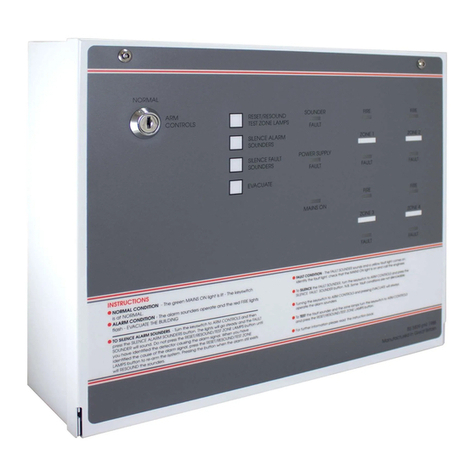
C-TEC
C-TEC FP4E installation instructions
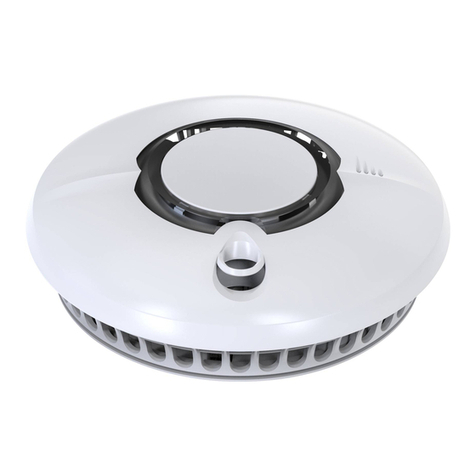
FireAngel
FireAngel Thermoptek ST-632 user manual
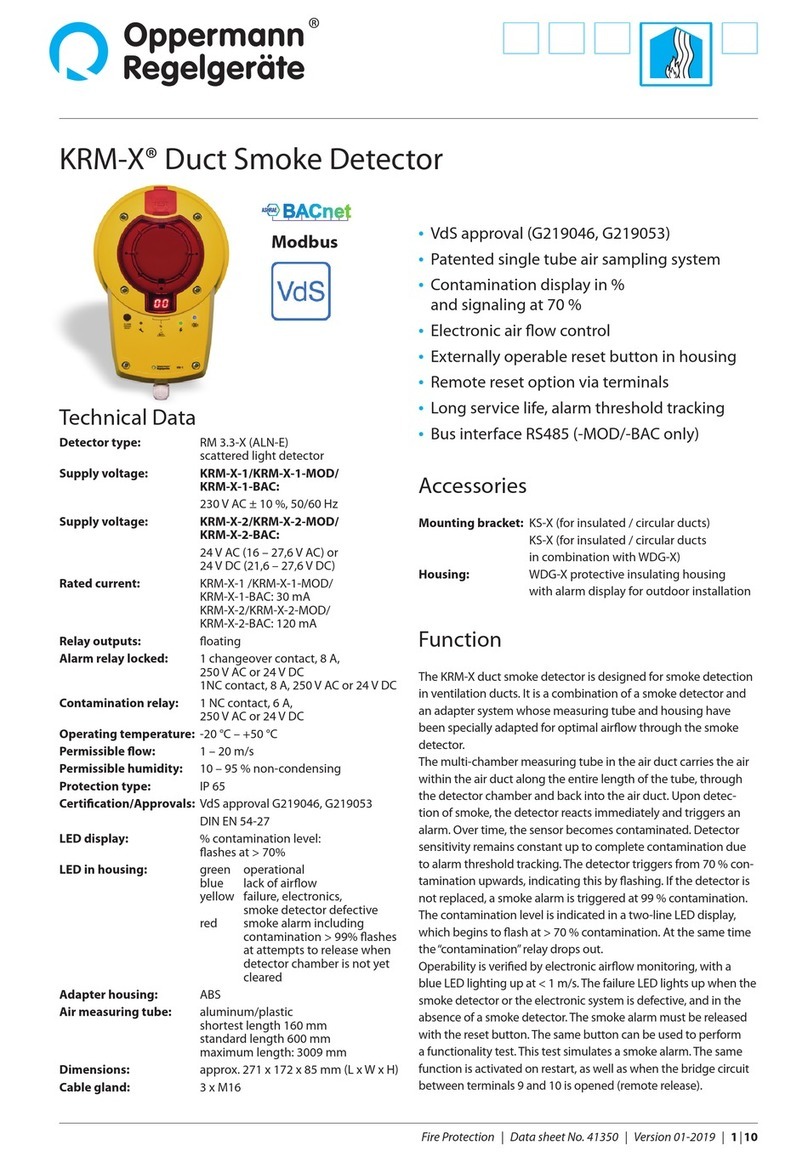
Oppermann Regelgeräte
Oppermann Regelgeräte KRM-X manual
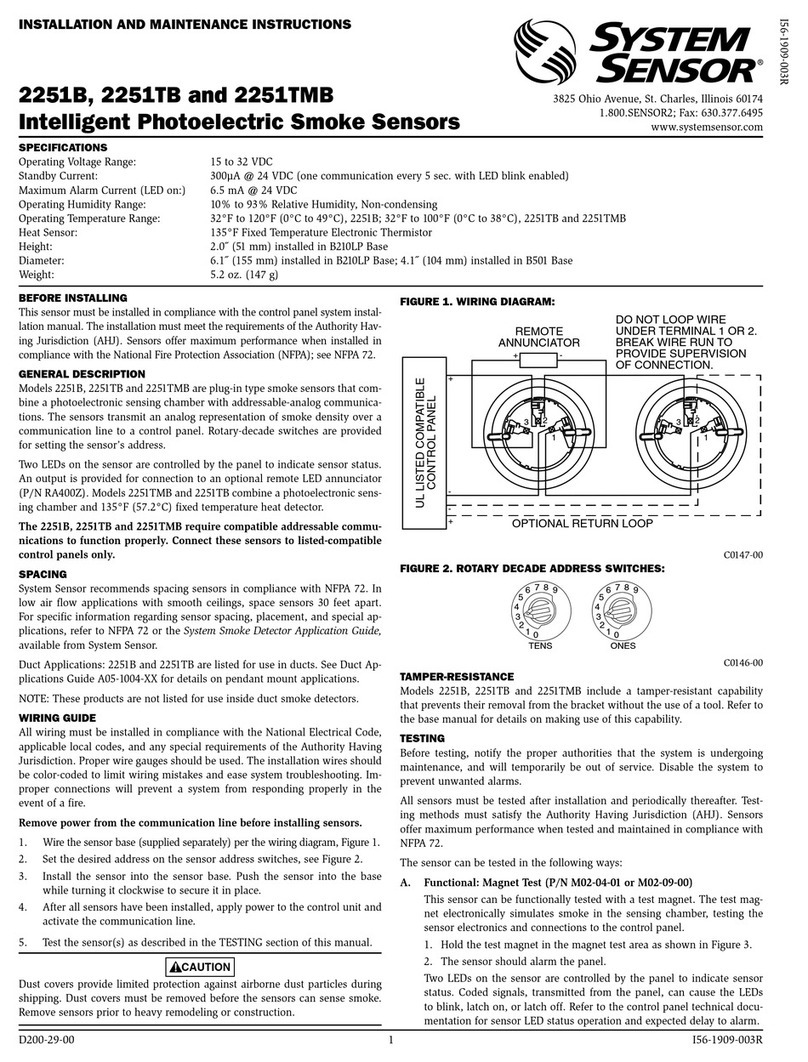
System Sensor
System Sensor 2251B Installation and maintenance instructions

Intec
Intec SM-501 Series Installation and maintenance instructions
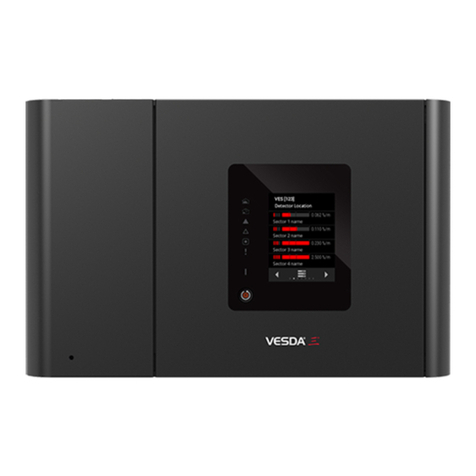
Xtralis
Xtralis VESDA Commissioning Guide
